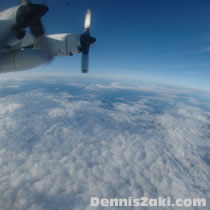
 |
|
|
August 20, 2009 Coast Guard assists international science community to study Arctic ice, ocean behavior in AlaskaFrom a US Coast Guard press release:NOME , Alaska - The Coast Guard in cooperation with several scientific agencies and the International Ice Patrol deployed an ocean drifting buoy in the Arctic Ocean north of the Bering Sea for the very first time Wednesday. 
"We are leaning forward to gain a thorough understanding of the cultural, environmental and operational challenges the Coast Guard faces in Northern Alaska and the Arctic domain. As such, we need to project a persistent presence in these remote regions to expand our knowledge of the environment and protect U.S. sovereignty," said Capt. Robert Phillips, Chief, Incident Management Branch Seventeenth Coast Guard District. "In order to accomplish these goals we are partnering with the scientific community and other federal agencies, such as NOAA, to join us in collecting data for future operations and a successful road ahead in the Arctic." Ocean drifting buoys have been used for research and data collection in the north Atlantic for years. The buoy was deployed from the back of a Coast Guard C-130 Hercules airplane from Air Station Kodiak with the help of personnel from the Coast Guard International Ice patrol headquartered in New London , Conn. The effort coincides with the Coast Guard's month-long operations on the North Slope and the summer 2009 expedition of the Coast Guard Cutter Healy. "This effort signals the beginning of airborne deployments by Coast Guard C-130 Hercules Arctic Domain Awareness flights in support of the buoy network," said Pablo Clemente-Colón, chief scientist of the National Ice Center and an oceanographer with NOAA who is currently deployed aboard the Coast Guard Cutter Healy. According to Clemente-Colón the deployment of this open ocean drifting buoy represents a contribution by the U.S. Interagency Arctic Buoy Program (USIABP) to the Arctic Observing Network (AON) and the International Arctic Buoy Program (IABP) to maintain a network of automatic data buoys to monitor synoptic-scale fields of surface air pressure, air temperature, and ice motion throughout the Arctic Ocean . He noted that the Coast Guard Cutter Healy, participating in the Joint U.S.-Canada Extended Continental Shelf (ECS) mapping mission, is also supporting the deployment of additional ocean drifters, seasonal ice buoys, and ice beacons for the USIABP. The ice drifting buoy uses a modified version of the World Ocean Circulation Experiment (WOCE) buoy. These WOCE buoys are drogued at 50 or 150 feet to track the deep water currents that affect iceberg drift. The drifters also measure the sea surface temperature using a thermister on the underside of the surface float. The drifters are further equipped with submergence sensors that indicate drogue loss. Buoys without drogues do not follow ocean currents well, because the surface float is significantly affected by winds and waves. Drifters transmit sensor data to satellites that determine the buoy's position and relay the data to Argos ground stations. Service Argos provides tracking and data services. The WOCE buoys the International Ice patrol use generally cost about $2,000 each. The International Ice Patrol deploys between 12 and 15 buoys each year in the Labrador Sea and North Atlantic region. The buoys are either ship deployed by vessels of opportunity or air deployed by Coast Guard C-130 Hercules aircraft during iceberg reconnaissance. Each buoy provides latitude and longitude, sea surface temperature, and submergence information. The buoy's locations and data can be seen at the Drifter Buoy Center or the WMO-IOC Buoy Server. The United States contribution to the IABP is coordinated through the United States Interagency Arctic Buoy Program (USIABP), which is managed by the National Ice Center (NIC) and the University of Washington Polar Science Center (PSC). The USIABP is a collaborative program that draws operating funds and services from a number of U.S. government organizations and research programs, which include the International Arctic Research Center, the National Aeronautics and Space Administration, the National Oceanic and Atmospheric Administration, the National Science Foundation (NSF), the Naval Oceanographic Office, the NIC, the Office of Naval Research, and the U.S. Coast Guard. From these contributions the USIABP acquires and deploys buoys on the Arctic Ocean , and supports the Coordination and Data Management for the IABP by the PSC. Further information regarding the Coast Guard's North Slope operations and Operation Arctic Crossroads can be found at the Coast Guard District Seventeen website. The Coast Guard Cutter Healy's summer and fall 2009 deployment can be followed at Coast Guard Cutter Healy website where you'll also find links to blogs from the science crews on board including the Arctic mapping team or the Alaska Logbook click on the CGCHealy label. Coast Guard C-130 flight on an Arctic Crossroads mission to NomeA flight on a US Coast Guard C-130 transport plane to Nome, Alaska on an Arctic Crossroads mission August 17th, 2009. Coast Guard Commandant Thad Allen hosted a climate change presser with officials from the Obama administration. © AlaskaReport.com All Rights Reserved. |
|